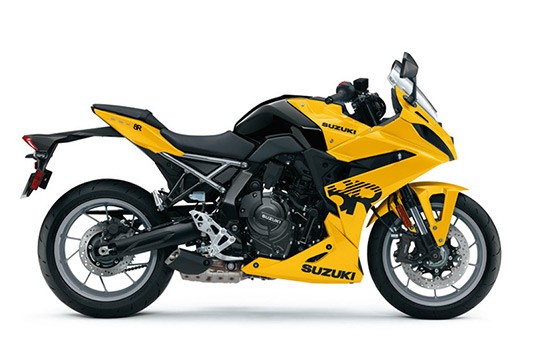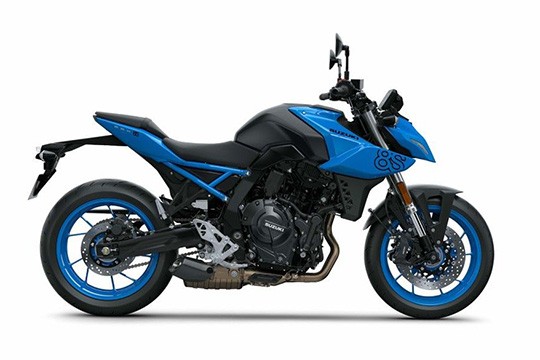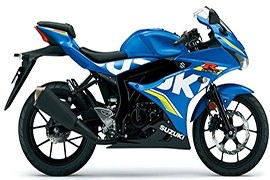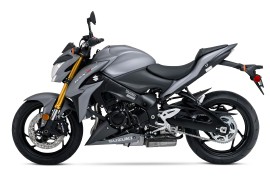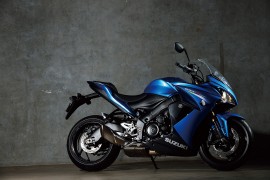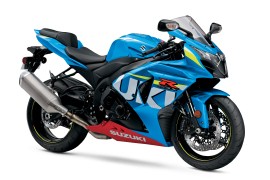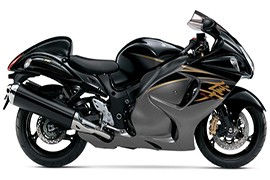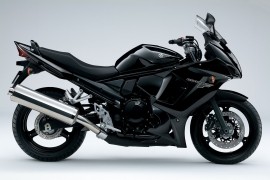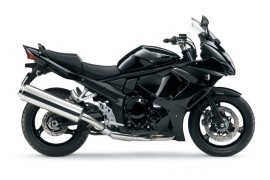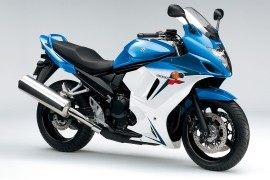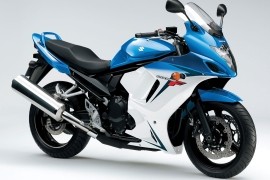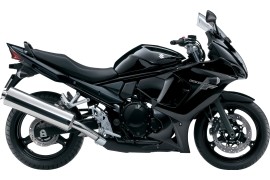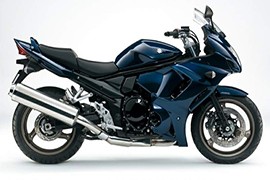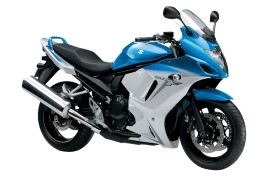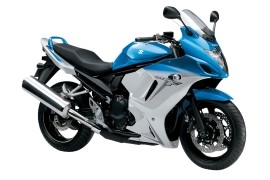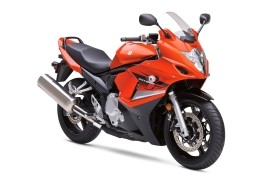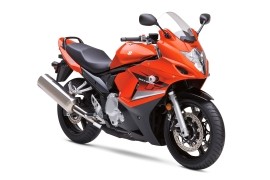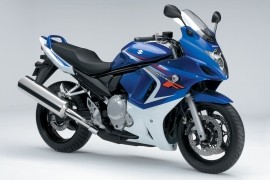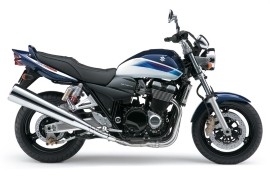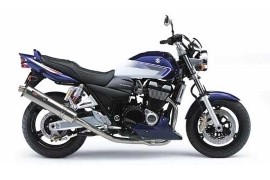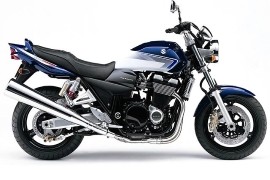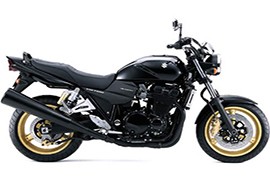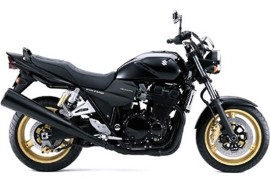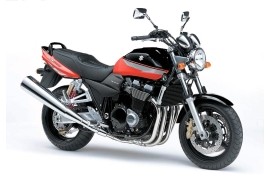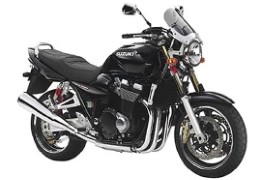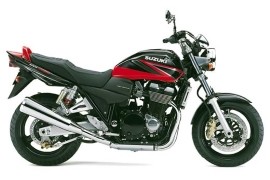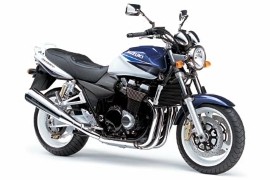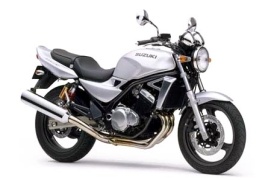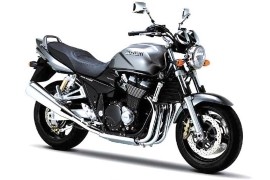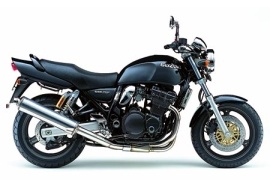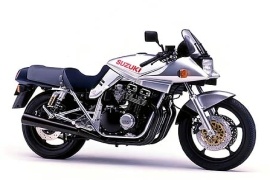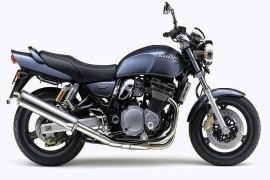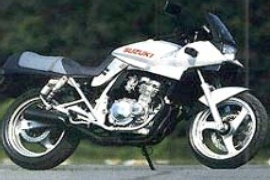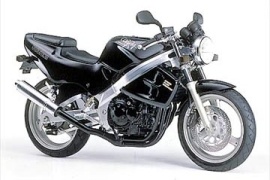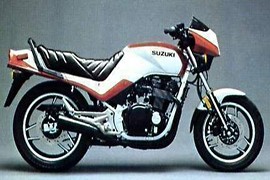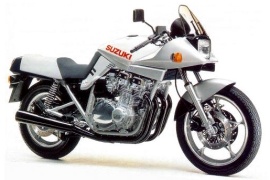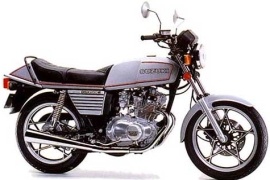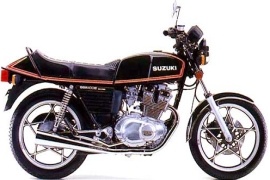SUZUKI GSX Models/Series Timeline, Specifications & Photos
First production year: 1979
The Suzuki GSX-R was a series of sports motorcycles made by Suzuki over several generations since 1984. The first GSX-R model debuted in 1984 and was for sale only in Japan, taking advantage of licensing laws, which prohibited motorcycles with engines larger than 400cc.
In 2023, the Japanese motorcycle manufacturer unveiled the new Suzuki GSX-8R sports model at the EICMA show in Italy, Milan. The bike was presented alongside the GSX-S1000GX crossover model.
The 2024 model year Suzuki GSX-8R is based on the GSX-8S naked model and is a sports model that allows riders of all ages to enjoy various types of riding. The bike is available in three color schemes: Metallic Triton Blue with Black, Pearl Ignite Yellow with Black, and Metallic Matte Sword Silver with red wheels at an MSRP of $9,440.
In the visual department, the bike packs a half fairing with a small windscreen, a two-piece dual seat, an under-belly exhaust system, a black-finished engine, and 10-spoke lightweight wheels.
The bike packs an inverted Showa SFF-BP telescopic fork on the front and a single shock absorber on the rear, delivering excellent suspension performance and handling.
The 2024 Suzuki GSX-8R takes power from a 776cc four-stroke parallel-twin liquid-cooled engine and sends it to the rear end through a six-speed manual gearbox with a wet multi-plate clutch and a final chain drive.
The GSX series was a range of sports touring machines manufactured by Suzuki from 1980. After the two-valve GS series, the first GSX motorcycles represented the next step in Suzuki's road bike range.
The two-valve engines remained in production in parallel with the four-valve units, while the two-valve four-cylinder machines gained a shaft drive and powered more touring-oriented models, such as the GS 850G and GS 1100G. The GSX series was represented by motorcycles with a performance orientation.
In 2023, the Japanese motorcycle manufacturer launched the Suzuki GsX-8S, a new machine designed and engineered from the ground up as a fresh naked streetfighter with sharp and agile performance suited for a vast range of riders.
The 2023 machine was equipped with a Suzuki Intelligent Ride System (SIRS) that included Suzuki Drive Mode Selector (SDMS) for engine map selection, Suzuki Traction Control System (STCS) with three modes and a kill switch, Suzuki's Bi-directional Quick Shift System for smoother and quicker gear shifts, Suzuki Easy Start System, and a Low RPM Assist function.
The 2023 Suzuki GSX-8S was powered by a newly-developed 746cc four-stroke two-cylinder liquid-cooled engine managed by a fuel injection system, boasting 83 hp at 8,500 rpm and 78 Nm (58 lb-ft) torque with a maximum peak force at 6,800 rpm.
The 2023 machine was available with Pearl Tech White, Pearl Cosmic Blue, and Metallic Matte Black No.2/Glass Sparkle Black liveries and was for sale with a base price starting at $8,849.
In 2018, Suzuki released the GSX-R125, an entry-level motorcycle to the GSX-R series of sportbikes designed to be enjoyed by less experienced and young riders. The 2018 GSX R-125’s styling was influenced by the aggressive and sharp design of more powerful bikes in the GSX-R portfolio.
The model featured a 124cc engine combined with a lightweight and compact chassis, which resulted in a smooth and satisfying acceleration feeling and enjoyable riding experience both on city streets or winding roads.
The bike was based on the fully faired style of the GSX-R series, with large 17 inches wheels both front and rear, petal-designed brake discs, and ABS as standard equipment. It also featured a single LED headlight, full LCD instrument display, and keyless ignition with the Suzuki Easy-start system, which fired up the engine at a single press of a button.
At its core, the bike featured a 124cc four-stroke one-cylinder liquid-cooled engine with a power output of 15 hp at 10,000 rpm and 11 Nm (eight lb-ft) of torque available at 8,000 rpm. The power, combined with a six-speed manual transmission and a dry weight of 134 kg (295 lbs), pushed the bike to a top speed of 111 kph (69 mph).
The 2018 Suzuki GSX-R125 was for sale in 2022, starting from $3,500.
Born on the racetrack and raised on the street, the 2016 GSX-S1000 derived from the legendary, championship-winning 2005-2008 generation GSX-R1000. The new GSX-S line-up carried the spirit of the Suzuki GSX-R to the street, with shared technology and components packaged into a chassis designed specifically for street riding comfort.
Focused on on-road handling and control, the GSX-S got a new main frame with the main tubes straight from the steering head to the swingarm for more rigidity and less weight, and the aluminum swingarm was taken as it is from the R model.
As standard, the bike featured three-stage traction control settings such as Sport, Road, and Wet, with the option of the system being completely disabled. Behind the handlebar, the instrument cluster featured a lightweight and brightness-adjustable LCD with readouts such as a speedometer, tachometer, odometer, driving range, consumption, and more.
Taking a step into the power department, the 2016 Suzuki GSX-S1000 borrowed the engine from the R1000 and updated it with new pistons and cams profiles to adjust the torque and power for the best road-driving balance. With a 998cc four-stroke four-cylinder liquid-cooled powerplant, the bike developed an output power of 143 hp at 10,000 rpm and 106 Nm (78 lb-ft) of torque with a peak at 9,500 rpm.
For stopping power, the model featured two 310 mm discs with four-piston Brembo calipers on the front wheel and a single 220 mm disc with a hydraulic caliper on the rear.
In 2016, Suzuki launched the GSX-S1000F, a standard motorcycle that belonged to the same family as the 1985 GSX-R750 and took its spirit on the streets but also was closely related to Suzuki's MotoGP machine, the GSX-RR.
The chassis was designed to be agile and fun to ride, with a lightweight and rigid frame and an aluminum swingarm. At each end of the frame, the bike featured lightweight cast-aluminum wheels dressed in Dunlop radial tires.
For braking power, the bike featured the same top-of-the-line radial-mount Brembo monoblock calipers like the GSX-R1000, with two 310 mm discs with four-piston calipers on the front and a 220 mm disc with a hydraulic caliper on the rear, both wheels equipped with ABS.
In the power department, the model took its thrust from a street-tuned engine that powered the GSX-R1000 and delivered smooth throttle response and crisp acceleration. It also packed a finely tuned fuel injection system with Suzuki Dual Throttle Valve (SDTV) system.
The 998cc four-stroke four-cylinder liquid-cooled engine installed on the lightweight chassis developed an output power of 143 hp at 10,000 rpm and 106 Nm (78 lb-ft) of torque with a peak at 9,500 rpm. The hot and burned gases produced by the engine were pushed through a four-two-one exhaust system designed to increase the output in the low-mid rpm range.
Tech-wise, the 2016 Suzuki GSX-R1000 featured a lightweight instrument cluster with a brightness-adjustable LCD and various readings such as a speedometer, tachometer, odometer, gear position indicator, traction control indicator for three different traction control modes, and much more.
The secret of the GSX-R1000's legendary performance was an unrivaled combination of power and precision handling.
Its powerplant featured cutting-edge designs, such as lightweight forged pistons designed with the Finite Element Method analysis, that provided incredible acceleration out of corners, matched by top-end performance.
Its chassis was designed for optimum rigidity and provided responsive steering and rock-solid stability even through wide-open sweepers. At the time, the bike was the lightest, most compact, aerodynamic, and best-handling GSX-R1000 bike ever built by Suzuki.
The bike's new bodywork was more compact, sleeker, and narrower than the previous model, which increased the aerodynamic efficiency with its smaller frontal area and also with its flat-top redesigned bolts for less air resistance.
With the Suzuki Drive Mode Selector (SDMS) system featured by the bike, the rider had at his disposal three engine power settings that fitted the personal style or various road conditions. Another great feature installed on the bike was the Quick Shift System that allowed the shift lever to be used without operating the clutch, which gave the bike uninterrupted acceleration at full throttle.
The 2016 Suzuki GSX-R1000 packed at its core a 998cc four-stroke four-cylinder liquid-cooled engine that developed a power output of 182 hp at 12,000 rpm and 117 Nm (86 lb-ft) of torque at 10,000 rpm. The power, combined with a six-speed manual transmission and a wet weight of 203 kg (448 lbs), resulted in a top speed of 299 kph (186 mph).
In 2016, Suzuki launched the GSX 1300R, famed as the fastest production motorcycle, at the time of its first release back in 1999, with a top speed of 303 to 312 kph (188 to 194 mph).
After countless engineering refinements of the original design, in 2014, the Hayabusa received Brembo monoblock high-performance calipers and Anti-lock Braking System (ABS), which combined with the fun and sporty ride condition at any speed and the aerodynamical all-round bodywork, the bike raised the bar high for rivals.
The 2016 Suzuki GSX 1300R featured a lightweight and rigid twin-spar aluminum frame that minimized weight and maintained high torsional strength, while the bridge aluminum swingarm had a cross-sectional shape designed for more rigidity.
In the power department, the Hayabusa featured a 1,340cc four-cylinder liquid-cooled fuel-injected engine with lightweight aluminum pistons, lightweight titanium valves, and iridium spark plugs that provided massive power, torque, and crisp acceleration. With the help of a six-speed manual transmission, the bike developed a power output of 196 hp at 9,800 rpm and 154 Nm (114 lb-ft) of torque at 7,200 rpm.
In addition, the model packed a Suzuki Drive Mode Selector (SDMS), which allowed the rider to choose between three engine map settings for personal performance preference or riding conditions.
Visually, the Hayabusa packed vertically stacked headlights that improved light intensity and distribution and matched the elegant flow of the bodywork, which offered great wind protection for both normal and tucked-in positions.
In 2015, Suzuki released the GSX-650F ABS, a sport touring motorcycle that in essence, was an updated Bandit that filled the void left by the retired Katana. The GSX-650F recipe proved to be a successful one as the bike offered a mixture of cool looks, power, and comfortable seating position with precise handling and plenty of usable power on tap, but also based on the GSX-R family, which retained certain design cues.
One of the key features of the 2015 GSX was the Anti-lock Braking System (ABS) that enhanced the safety of the bike with two floating 310 mm discs and four-piston calipers on the front and a 240 mm disc with a two-piston caliper on the rear.
The double steel cradle frame provided excellent balance with unmatched comfort and crisp handling, while the wide one-piece seat increased rider and passenger comfort with the handlebar rubber-mounted for fewer vibrations.
The 656cc engine featured Suzuki Dual Throttle Valve fuel injection with lightweight and compact four-hole injectors that offered smooth acceleration and more output power. To meet the EURO3 regulations, the bike featured a large-capacity exhaust system with a high-capacity catalyzer and an oxygen sensor while still offered strong performance throughout the rpm range.
The 2015 GSX-650F ABS motorcycle with its four-stroke four-cylinder liquid-cooled engine delivered an output power of 86 hp with a peak at 10,500 rpm and 61 Nm (45 lb-ft) of torque available at 10,500 rpm. Combined with a six-speed manual transmission and a wet weight of 245 kg (541 lbs), the bike reached a top speed of 211 kph (131 mph).
In 2015, Suzuki released the GSX-1250FA, a sport-touring machine sold in Canada and the UK, based on the new generation of big Bandit machines that were transformed into members of the GSX family, which resulted in a successful transformation because the bike retained the best features of both worlds.
The GSX motorcycles delivered punchy throttle response and featured aggressive design and top-drawer maneuverability while the all-rounder practicality shined through thanks to excellent long-range seating comfort, predictable power delivery in the mid-range, and a non-intimidating feel.
The bike featured an optional sport-touring accessory pack that included a three-piece high-quality luggage system with 33-liter side panniers and a 37-liter top box. The contoured seat was 20 mm vertically adjustable by switching the mounting spacers between the seat and the frame seat rails, which offered enhanced long-distance comfort.
The classic tube-frame chassis was designed for an excellent balance between sporty handling and highway cruising comfort and dressed in a full fairing with vertically stacked headlights that increased the open road comfort.
As for power, the 2015 GSX-1250FA took its thrust from a 1,254cc four-stroke four-cylinder liquid-cooled engine that delivered an output power of 97 hp at 7,500 rpm and 108 Nm (80 lb-ft) of torque at 3,500 rpm.
In addition, the bike featured standard equipment such as a large-capacity fuel tank, a center stand, and an instrument cluster that offered a variety of gauges.
In 2014, Suzuki released the GSX-650F ABS, a sport-touring motorcycle derived from the 600cc GSX-R supersport-class bike but engineered to deliver more street-able performance in less extreme scenarios.
The engine displacement got bigger, but the peak power and torque deployment points have been shifted lower down the rev scale for a leaner riding experience. The GSX-650F ABS was delivered with an Anti-Lock Braking System and Electronic Fuel Injection (EFI) as standard options and was a comfy all-rounder suitable for both commuting and fast fun around tight bends.
The bike featured a double cradle steel frame that provided excellent balance, nimble handling, and unmatched comfort with a rubber-mounted handlebar for reduced vibrations and a 41 mm fork on the front designed for a smooth ride.
The 2014 Suzuki GSX-650F ABS took its thrust from a 656cc four-stroke four-cylinder liquid-cooled engine that delivered a power output of 86 hp at 10,500 rpm and 61 Nm (45 lb-ft) of torque with a peak at 10,500 rpm. With a six-speed manual transmission and a wet weight of 245 kg (541 lbs), the bike reached a top speed of 211 kph (131 mph).
The hot burned gases escaped from the engine through a large-capacity exhaust system fitted with a high-capacity catalyzer and an oxygen sensor required to meet the EURO3 regulations but still provided strong performance throughout the rpm range.
In 2013, Suzuki launched the GSX-650F, a sport-touring motorcycle that was a more civilized version of the 600cc Gixxer, a bike whose engine derived from the supersport power plant but was tweaked differently to provide a smoother, more predictable feel in the urban clutter.
Still a fast and agile bike, the GSX-650F ABS smoked other traffic at fast hauls along the highway and city holes hot starts. However, the bike came with better ergonomics and improved riding comfort. Although engineered as a sporty all-rounder, it was only natural that riders could easily spend long hours in the saddle without being forced to ride in a too-racy position.
As standard, the bike featured ABS braking and Electronic Fuel Injection (EFI) for smooth acceleration and more power output with lightweight and compact four-hole fuel injectors.
The 2013 Suzuki GSX-650F took its thrust from a 656cc four-stroke four-cylinder liquid-cooled engine that developed a power output of 86 hp at 10,500 rpm and 61 Nm (45 lb-ft) of torque with a peak at 10,500 rpm. Combined with a six-speed manual transmission and a wet weight of 245 kg (541 lbs), the bike registered a top speed of 211 kph (131 mph).
Visually, the bike was dressed in a stylish full fairing designed with cues from the GSX-R motorcycle with a sport-inspired look with full-fairing protection for the rider and a wide and comfortable seat with a low height for more comfort for the rider and passenger.
The GSX-650F was a sport touring motorcycle made by Suzuki, which in essence, was an updated Bandit that filled the gap left by the retired Katana.
In 2012, the Japanese motorcycle manufacturer launched the GSX-650F ABS, a fuel-injected bike that featured a balance of sportbike excitement and versatile performance with crisp handling, low-mid range power, and an upright seating position.
The bike was inspired by the GSX-R range and packed the dynamic style of a fully faired sportbike but delivered enhanced comfort thanks to its high handlebars and low-mounted footpegs.
The double-cradle steel frame provided excellent balance and nimble handling, while the wide, comfortable one-piece seat offered a low seat height, and the rubber-mounted handlebar reduced vibrations.
In the performance department, the 2012 Suzuki GSX-650F ABS featured a compact 656cc four-stroke four-cylinder liquid-cooled engine fed by the Suzuki Dual Throttle Valve (SDTV) fuel injection system for more power output, while the cylinders featured Suzuki Composite Electrochemical Material (SCEM) plating for a smaller size and better heat transfer.
The bike delivered an output power of 86 hp at 10,500 rpm and 62 Nm (45 lb-ft) of torque at 10,500 rpm, converted into speed by a six-speed manual transmission, which pushed the bike to a top speed of 211 kph (131 mph).
As for stopping power, the wheels were fitted with two 310 mm discs with a couple of four-piston calipers on the front and a 250 mm disc with a single-piston caliper on the rear.
The GSX 1250FA might pack a 257kg fully-fuelled weight, but it hides it well. The seat is low and the bars raised, putting you in a good position for low-speed traffic-splitting or hustling along an open road.
In 2011, Suzuki released the GSX-650F ABS, a middleweight outright sports street bike that boasted some of the coolest features of the top-drawer Gixxers but was a more tamed machine better suited for the city. The 2011 GSX-650F was a motorcycle built on the acclaimed heritage of the supersport GSX but delivered a whole new experience.
The fuel-injected model offered an ideal balance of sportbike excitement with an all-around versatile performance, which proved that sports bikes were not necessarily one-dimensional, topped by an increased safety level with ABS braking.
The bike packed a double cradle steel frame that provided crisp handling and unmatched comfort with a full fairing with styling cues borrowed from the high-performance GSX-R series for a sport-inspired look. Added to the overall comfort, the bike packed a wide seat with low seat height and a compact fuel tank designed for easy reach to the handlebar.
In the power department, the engine featured a SUZUKI Dual Throttle Valve (SDTV) fuel injection with four-hole injectors for smooth acceleration, Suzuki Composite Electrochemical Material (SCEM) coated cylinders, and a large capacity exhaust system with a high-capacity oxygen sensor for EURO3 regulation purposes while still provided strong performance.
The 656cc four-stroke four-cylinder liquid-cooled engine delivered a power output of 86 hp at 10,500 rpm and 61 Nm (45 lb-ft) of torque at 10,500 rpm. Combined with a wet weight of 245 kg (5411 lbs) and a six-speed manual transmission, the 2011 Suzuki GSX-650F ABS registered a top speed of 211 kph (131 mph).
In 2010, Suzuki released the GSX-650F ABS, a motorcycle best suited for those riders who liked the sporty attitude and grit of the 600cc Gixxer but didn't want a fully-fledged sports bike.
The 650F ABS bike was the civilian version of the GSX-R600, which boasted many features inspired by the track machine but put together in a package that was significantly more comfortable for longer hauls and more suitable for daily city slicing.
The bodywork and windscreen were designed for increased weather protection, while the engine received a tune for better response in the lower rpm scale. Designed to mix performance and comfort, the 2010 Suzuki GSX-650F ABS was Suzuki's best compromise between the two models.
The bike was assembled on a double cradle steel frame that provided excellent balance, crisp handling, and a great amount of comfort with an overall sporty feel. Dressed in a stylish full fairing with lines taken from the GSX-R series for a sportier look, the bike offered full fairing protection for the rider, a comfortable riding position with a wide one-piece seat, and a compact fuel tank designed for an easy reach to the handlebar that was rubber mounted for fewer vibrations.
The compact engine featured Suzuki Dual Throttle Valve (SDTV) fuel injection with four-hole compact and lightweight fuel injectors that provided smooth acceleration and an output increase. With a 656cc displacement, the four-stroke four-cylinder liquid-cooled powerplant delivered an output power of 86 hp at 10,500 rpm and 61 Nm (4 lb-ft) of torque available at 10,500 rpm.
When the power was combined with a six-speed manual transmission and a wet weight of 245 kg (541 lbs), the result was a top speed of 211 kph (131 mph).
Even though the pictured bike is a non-ABS model, Suzuki has also manufactured another version of the 2009 MY GSX-650F. The GSX-650F ABS was exactly the same with the base model, but the rotor carriers had the ABS sensor rings front and rear, and the total weight of the bike was a tad bigger, because of the added bulk of the ABS modulator.
As for the rest, you get the same sport-natured all-rounder machine, a middleweight bike which provides a reassuring feel and tamed performance to less-experienced riders, but which can also be sharp as a knife when ridden hard by seasoned ones.
The 2008 MY GSX-650F carries on the design cues introduced by the previous year machine, with solid similarities with the supersport-class Gixxer, but sporting easy-to-spot differences, too. For starters, you'll get a one-piece seat and traditional forks, while the lines of the bodywork are less aggressive, even despite the unmistakable GSX DNA.
If anything, the GSX-650F is a more tamed, street-friendly sport bike derived from the GSX-R600, but tuned for daily riding and better comfort.
In 2008, Suzuki launched the GSX-650F, a motorcycle that featured the sporty nature of the 600cc Gixxer combined with better street ability and increased versatility, all packed into a bike that was able to serve as a daily city slicer and a weekend warrior's weapon of choice. The resemblance with the GSX-R600 machine was striking from far, but closer, the bike revealed noticeable architectural differences aimed at more comfort and all-day usability.
The bike was intended as an entry-level machine to attract new or more skilled riders to the world of modern sports bikes. The model featured a new full fairing design with styling cues grabbed from the high-performance GSX-R series for a sportier look.
The compact fuel tank was designed for easy reach to the handlebar and rubber mounted for fewer vibrations, and also featured a more upright seating position that made all-day rides more comfortable.
The 2008 Suzuki GSX-650F took its thrust from a 656cc four-stroke four-cylinder liquid-cooled engine that delivered an output power of 86 hp with a peak at 10,500 rpm and 61 Nm (45 lb-ft) of torque at 10,500 rpm. Combined with a six-speed manual transmission and a wet weight of 245 kg (541 lbs), the bike registered a top speed of 211 kph (131 mph).
For suspension, the model packed a 41 mm spring preload adjustable fork on the front and a link-type with adjustable preload and rebound on the rear.
The stopping power was handled by a couple of four-piston Tokico calipers that engaged two 310 mm discs on the front and a one-piston hydraulic caliper that squeezed a 240 mm disc on the rear.
Even though in certain markets the GSX 1400 is no longer sold, the model lives on and the 2007 MY retains all the street cred of the previous generation. Already a sizzling hot naked machine, the GSX 1400 still oozes retro sport bike styling, with the flared exhaust being an attention-grabber, and the oil-cooled massive engine dominating the mid-ship segment.
For the 2007 model, the graphics have been updated, but no tech specs were altered.
The 2006 MY GSX 1400 Yoshimura Edition represents the end of the road for this model. The emission regulations in Europe are becoming stricter by the year and this caused Suzuki to pull the plug on the model in several countries, including the UK. The GSX 1400 Yoshimura Edition is dedicated to the loyal British fans, and arrives with an aftermarket exhaust system, a chin spoiler and a limited edition purple livery.
On the tech side, the GSX 1400 Yoshimura Edition is identical to the base version, maybe with some extra grunt in certain rpm ranges, courtesy of the high-performance silencers.
If anything, the 2006 MY GSX 1400 is not a bike for the faint-hearted. You're getting quite a lot of bike for the money, with a brawny air/oil-cooled 1402cc in-line four loaded in a retro naked frame and set for the ultimate street thrill. For some markets, the 2006 MY is the last GSX 1400 which will be sold, with the strict Euro emission regulations putting an end to this bike.
Still, if a classic road racer with a slightly retro vibe is what you're after, then the GSX 1400 is your tool. There's hardly a better bike for sweet autumn rides through the countryside, and which can do just as well in the city or on the highway.
In 2004, the Japanese manufacturer launched the Suzuki GSX-1400Z, which was not only modified on the surface but also featured changes to the internal guts.
The fuel injection system was revisited for better fuel intake and acceleration at the lower speed range and packed an automatic fast idle system. An internally coded ignition key was added as an immobilizer system, and the aluminum cylinder walls were coated with something called Suzuki Composite Electrochemical Material (SCEM) that improved heat transfer. The front brake lever was reduced to a five-step adjustment from the previously six-step.
Another easy-to-spot difference was the new exhaust system, revised from the classic twin four-two-two system into a four-two-one pipe with a stainless-steel muffler that reduced the overall weight by three kg (6.6 lbs) but also reduced the torque by two Nm. The feel and looks of the bike remained unchanged, with the Suzuki logo changed to a single "S" and with available colors such as the Pearl Deep Blue with Pearl White, Pearl Red with Solid Black, and Solid Black.
In the power department, the 2004 Suzuki GSX-1400Z took its thrust from a 1,402cc four-stroke four-cylinder air/oil-cooled engine that delivered a power output of 105 hp at 6,800 rpm and 124 Nm (91 lb-ft) of torque at 5,000 rpm.
For suspension, the model packed a 46 mm telescopic fork with adjustable preload, compression, and rebound on the front while the rear was assisted by a fully adjustable piggyback shock.
Ever fancied an all-black GSX 1400? If the answer is yes, then seeing the 2005 MY Z-version of the GSX 1400 should definitely raise your pulse. The GSX 1400 Z is black in almost its entirety, save for several accents. An elegant, contrasting golden trim was chosen for the wheels, while aluminium and chrome details can be found on the rear passenger peg supports and rear shocks, instrument casings and headlight bezel.
As for the silencer and the collectors, they are as black as night,a dding to the overall sober elegance of the bike.
The biggest change in the architecture of the 2005 MY GSX 1400 is the new exhaust system. The classic 4-into-2-into-2 was replaced by a 4-into-1 design which lowered the overall weight of the machine. Even though the peak torque figure dropped 2 Nm, the 2005 MY GSX 1400 remains a sizzling hot ride which is equally great for both urban and highway rides, with its smooth cornering capabilities making it great for leisurely countryside riding,a s well.
Like other bikes in the same model year, the new GSX 1400 dropped the lettering badge and replaced it with an S emblem.
It is not known whether a production version of the 2004 MY GSX 1400 Data has ever seen the light of day or this was only a prototype. Suzuki introduced the GSX 1400 Data at the Tokyo Motor Show, with an accompanying catalog, explaining the extra features the bike was equipped with. And no, it was not about the retro windshield.
Suzuki loaded a lot of sensors on the GSX 1400 and linked them to a new on-board computer. The sensors would collect suspension travel data and compiled it with the GPS records the computer stored as you rode. The compiled data could then be analyzed on a home computer and offer the rider with the ideal settings in relation with the roads he or she is about to take on.
The Suzuki GSX1400 was manufactured between 2001 and 2008 as a muscle bike intended to deliver more power, torque, and up-to-date technology than its similar sibling, the Bandit 1200.
At first, the bike was manufactured only for Japan and Europe, although they tried to make it available in the US and Canada. With a redline at 9,000 rpm, the GSX1400 didn't require more than 7,000 rpm because it had a strong low and mid-range performance.
Over the years, the UK models changed in detail, such as the wheel color changed from white to black, the four-in-two exhaust changed to a four-in-one system, and the Yoshimura branded mufflers.
In 2004, Suzuki launched the GSX1400 model, which came with a new graphic design for the tank and the tail section, while the wheels received a black coating that matched the darkened trim of the engine and engine covers.
The sober livery made the GSX1400 look more aggressive, maybe because it was less flashy. Still, the retro vibe was intact, with the dual flared exhaust silencers and their chrome finish, the round headlight, and the one-piece, two-up profiled seat.
In the power department, the 2004 Suzuki GSX1400 had its heartbeat set by a 1,402cc inline-four 16 valves air/oil-cooled engine that delivered 106 hp at 6,800 rpm and 123 Nm (91 lb-ft) of torque with a peak at 5,000 rpm.
The 2003 model year has no significant changes over the previous iteration. However, if you see a GSX 1400 with the springs of the rear shocks painted red, this means you;re looking at a machine manufactured and sold in the Japanese market. For some reason, the Silver Metallic bikes have only been offered as a domestic treat. The rest of the bikes have white coated wheels, which turned out to be a pain the back to clean.
The Suzuki GSX 250FX got a new four-cylinder water-cooled engine with 30 degree, valve angles and 12,2:1 compression ratio. Together with the 30 mm carburetors and 4-1 exhaust system the engine can deliver 40 hp (29.8 Kw) at 14.000 rpm. The form of the double craddle frame is unique and reminds of the Suzuki racers aluminum box type frames, althought it's made of steel pipe.
In 2002, Suzuki released the GSX-1400, a large-capacity naked retro-style motorcycle that was the best compromise between the muscle bikes of the 1980s and modern technologies.
Based on an air-cooled design, the model’s engine was updated with a Suzuki Dual Throttle Valve (SDTV) fuel injection system that was taken from the GSX-R series and was returned for more grunt in the low rpm range but also handling well in the mid-range rpm.
The power figures of the bike were achieved by a 1,402cc four-stroke four-cylinder air/oil-cooled engine that delivered a power output of 105 hp at 6,800 rpm and 126 Nm (93 lb-ft) of torque at 5,000 rpm. The power, combined with a six-speed manual transmission and a dry weight of 228 kg (503 lbs), resulted in a top speed of 233 kph (145 mph).
The chassis consisted of a tough steel tube frame that was well equipped with a 46 mm telescopic fork on the front and a fully adjustable piggyback shock absorber on the rear that offered a plush ride while the stopping power was generated by a couple of six-piston calipers pressing two 320 mm discs on the front and a 260 mm disc squeezed by a two-piston caliper on the rear.
The 2002 Suzuki GSX-1400 motorcycle featured a broad and well-finished 22-liter fuel tank that offered a decent touring range between 250-300 km (155-186 miles) and a plain and simple instrument cluster with two binnacle style gauges and LCD inserts that provided two trip meters, odometer, clock, and a fuel gauge.
My GSX 750 Inazuma has a 750 cc engine capacity and can provides ample power and torque. The GSX has a retro design roadster based around the eldery oil-cooled inline four engine used in the GSX 750 Sports Tourer. A steel tube cradle frame, alumminium twin shock swingarm and conventional forks provides capable if basic handling.
In 2000, there was still people who wanted to buy a new GSX 1100S Katana. The clutch was now electrically power assisted and the front suspension infinitely adjustable. Rear shocks were updated from traditional upright shockers to modern double tube upside down type shockers with gas chamber attached to the side.
It is currently only available in the Japanese market Inazuma (lightning) resource is an old familiar. 1986 prepared the GSX-R to 1100, and then returned to the bandit the air, oil-cooled four-cylinder. The Inazuma appearance and dimensions are identical to the success of the GSX 750.
In 1991, Suzuki released the GSX 250 S, a sports motorcycle that featured a newly engineered lightweight and high-performance 250cc engine based on the Bandit 250 model. The model’s engine was tuned for optimum performance in the low-mid rpm range to achieve excellent rideability on the streets.
For a dynamic and memorable style, the liquid-cooled engine was fitted with cooling fins inspired by the air-cooled models. The 1991 Suzuki GSX 250 S Katana featured a four-in-one exhaust system with excellent exhaust efficiency and a rear suspension equipped with a reservoir tank.
The motorcycle had its heartbeat set by a 248cc four-stroke four-cylinder liquid-cooled engine with a power output of 40 hp with a peak at 13,500 rpm and 26 Nm (19 lb-ft) of torque available at 10,000 rpm bolted to a six-speed constant mesh manual transmission.
Onto the steel pipe double cradle frame, the telescopic fork on the front and a swingarm coupled to a dual shock with rebound damper on the rear were acting as a suspension, while the stopping power was provided by two 300 mm discs with two-piston calipers on the front and a 240 mm disc on the rear.
The bike tipped the scale at 160 kg (353 lbs) dry weight and had a top speed of 174 kph (108 mph).
In 1989 Suzuki presented a new model, GSX 250S Cobra. In short terms you can say that it was a naked version of the Suzuki racing replica GSX R250R. It shared the same mechanics but didn't have the GSXR's fairing and the twin disc front brake and the 18-inch rear wheel. The Cobra was a fast and advanced bike. Unfortunately the GSX 250 bandit was released only three months after the CobraInterestingly a GSX 250S Cobra, Suzuki is still produced for the Japanese market, now a 45 hp (33 Kw) @ 15.000 rpm ‘four’ and weighing less than the original twin, how much fun might that be, in the unlikely event of Suzuki exporting them to European market.
The 1983 Suzuki GSX 550 is a motorcycle model from Suzuki. The Sport Tourer was produced from 1982 to 1986 in two model series and three different versions (EU, ES, EF). The additions behind the model designation indicate the type of cladding.
The GSX 1100S Katana was by no means all smart suit and no substance; far from it. Underneath the radical looks there lurked a very fine motorcycle, directly developed from worthy generations of the GS model. In fact the GSX 1100S was no more than a lightly tweaked and tarted GSX 1100E, with all the rumbling reliability this implies.
The GSX 250 and GSX 400 are the earliest two cylinder Suzuki models. Since then Suzuki has expanded its range of four-stroke machinery and continued setting the trend in the performance and handling stakes, something which has often caused the opposition to rush back to their respective drawing boards in frantic attempts to come up with a product that is as good as or superior to the Suzuki item. Suzuki's latest offering in the 250 cm3 class lives up to the firm's reputation of respectable performance and fine handling. It too, is a speedy, reliable and well mannered motorcycle.
GSX400E was presented for the first time in Japan, in 1979 and one year later it hit the European roads too. Here it replaced the known GS425.
